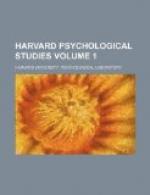[2] Bentley, I.M.: ’The
Memory Image and its Qualitative
Fidelity,’ Am. Journ.
of Psychol., 1899, XI., pp. 1-48.
Of the many memory problems as yet unattacked, that of the control of the mental image is one of the most interesting. The visual image obviously offers itself as the most accessible and the experiments described in this report were undertaken with the purpose of finding out something about the processes by which control of this image is secured and maintained. The report naturally has two aspects, one numerical and the other subjective, presenting the statements of the subjects as to their inner experiences.
The term ‘suppression’ is used as a convenient one to cover the enforced disappearance of the designated image, whether it be directly forced out of consciousness (a true suppression) or indirectly caused to disappear through neglect, or limitation of the attention to the other image which is to be retained.
As this was an investigation of the control of memory images, the presence of these images under conditions most favorable to their vividness and distinctness was desirable. An immediate mental recall at the end of five seconds of visual stimulation, under favorable though not unusual conditions of light, position and distance, seemed most likely to secure this desideratum. Experimentation showed that five minutes was, on the whole, a suitable period in which to secure the information needed without developing a fatigue in the subject which would vitiate the results.
The experiments made in the visual field were restricted to visual memory images which were called up by the subject during the five minutes succeeding a five seconds’ presentation of one or two objects. The subject sat, with his eyes closed, about four feet from a wall or screen, before which the object was placed. At a signal the eyes were opened, and at a second signal five seconds later they were closed. If an after-image appeared the subject reported its disappearance, and then called up the image of the object just presented, and reported as to its clearness, vividness, persistency and whatever phenomena arose; and when directed he sought to modify the image in various ways to be described later.
There were six subjects in experiments conducted during the winter of 1900-1901, and six (five being new ones) in experiments of the fall of 1901. They were all good visualizers, though they differed in the readiness with which they visualized respectively form or color.
The experiments of the first few weeks were designed to establish the fact of control by the subjects over a single visual memory image as to its position, size, outline, color, movement and presence. In general it was established that a considerable degree of control in these particulars existed in these subjects.
Later, two objects were presented at a time, and were such small articles as a glass ball, a book, a silk purse, an eye-glass case, an iron hook, and so forth. Still later, colored squares, triangles, or discs were used exclusively.




